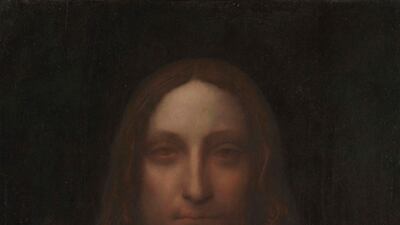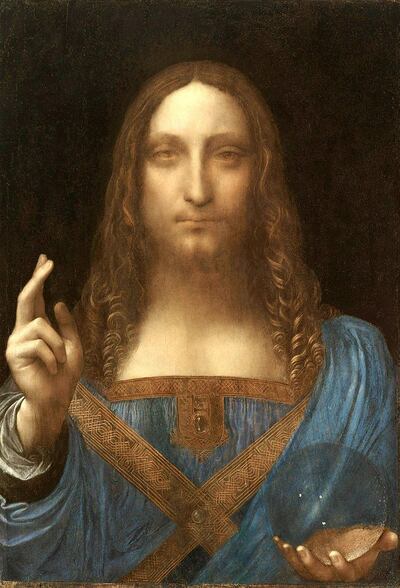There are several mysteries surrounding Leonardo da Vinci's elusive Salvator Mundi – and computer scientists in the US may have just solved one of them. Specifically, the mystery of the ethereal, clear orb held by the painting's Christ figure.
Considered an original Leonardo by a number of scholars, the Salvator Mundi became the world's most expensive painting after it was bought for $450.3 million (Dh1.65bn) at a Christie's auction. The orb, which symbolises the world and relates to the painting's title, is a key component of the work.
In their paper, Marco Zhanhang Liang, Michael T Goodrich and Shuang Zhao from the University of California, Irvine, claim that the orb in the painting is an accurate and realistic depiction of a hollow glass object.
The scientists studied the optical accuracy of the orb through a combination of “physically based rendering”, a computer graphics tool that can simulate light in virtual scenes, and 3D modelling.
Why is such a finding important? The orb has been a touchstone for scholars with regard to the authenticity of the painting. If the orb were a solid mass, then it would produce inverted reflections and distortions of the objects around it, including the figure of Christ. Given Leonardo’s deep interest in optic studies at the time the work was produced, why would he decide to render these distortions incorrectly? Such questions have led people like ArtWatch UK director Michael Daley to cast doubt on the painting’s true creator.
Others, including a Christie’s spokesperson, have purported that Leonardo deliberately painted it in this manner because “it would be too distracting to the subject of the painting” otherwise.
With this new research, Liang, Goodrich and Zhao claim that Leonardo’s depiction would have been physically possible in the real world given that the orb were made of thin glass.
Through their 3D modelling, they calculated the orb’s measurements, suggesting that it would have been 1.3 millimetres thick with a radius of 6.8 centimetres. “Our experiments show that an optically accurate rendering qualitatively matching that of the painting is indeed possible using materials, light sources, and scientific knowledge available to Leonardo da Vinci circa 1500,” the scientists wrote in the paper, which is yet to be published in a peer-reviewed journal.
This also suggests that da Vinci would have applied his knowledge of optics to render the object realistically.
Not everyone is convinced by these findings, however. Though Leonardo scholar Martin Kemp has stated he believes in the painting's authenticity, he told Live Science that "the paper of the sphere is just one of many examples of scientists making ill-judged interventions in Leonardo studies based on ignorance of the sources".
For Kemp, the artist would not have necessarily tried to copy reality, as he has taken creative license with scale in previous works, such as his Madonna and child paintings. He believes that Leonardo would have instead chosen to tweak reality for the sake of a more aesthetically pleasing composition.
THE CLOWN OF GAZA
Director: Abdulrahman Sabbah
Starring: Alaa Meqdad
Rating: 4/5
The Brutalist
Director: Brady Corbet
Stars: Adrien Brody, Felicity Jones, Guy Pearce, Joe Alwyn
Rating: 3.5/5
SERIES INFO
Schedule:
All matches at the Harare Sports Club
1st ODI, Wed Apr 10
2nd ODI, Fri Apr 12
3rd ODI, Sun Apr 14
4th ODI, Sun Apr 16
UAE squad
Mohammed Naveed (captain), Rohan Mustafa, Ashfaq Ahmed, Shaiman Anwar, Mohammed Usman, CP Rizwan, Chirag Suri, Mohammed Boota, Ghulam Shabber, Sultan Ahmed, Imran Haider, Amir Hayat, Zahoor Khan, Qadeer Ahmed
Zimbabwe squad
Peter Moor (captain), Solomon Mire, Brian Chari, Regis Chakabva, Sean Williams, Timycen Maruma, Sikandar Raza, Donald Tiripano, Kyle Jarvis, Tendai Chatara, Chris Mpofu, Craig Ervine, Brandon Mavuta, Ainsley Ndlovu, Tony Munyonga, Elton Chigumbura
WOMAN AND CHILD
Director: Saeed Roustaee
Starring: Parinaz Izadyar, Payman Maadi
Rating: 4/5
MATCH INFO
Manchester United v Manchester City, Wednesday, 11pm (UAE)
Match is on BeIN Sports
The candidates
Dr Ayham Ammora, scientist and business executive
Ali Azeem, business leader
Tony Booth, professor of education
Lord Browne, former BP chief executive
Dr Mohamed El-Erian, economist
Professor Wyn Evans, astrophysicist
Dr Mark Mann, scientist
Gina MIller, anti-Brexit campaigner
Lord Smith, former Cabinet minister
Sandi Toksvig, broadcaster
The bio
Favourite vegetable: Broccoli
Favourite food: Seafood
Favourite thing to cook: Duck l'orange
Favourite book: Give and Take by Adam Grant, one of his professors at University of Pennsylvania
Favourite place to travel: Home in Kuwait.
Favourite place in the UAE: Al Qudra lakes
What the law says
Micro-retirement is not a recognised concept or employment status under Federal Decree Law No. 33 of 2021 on the Regulation of Labour Relations (as amended) (UAE Labour Law). As such, it reflects a voluntary work-life balance practice, rather than a recognised legal employment category, according to Dilini Loku, senior associate for law firm Gateley Middle East.
“Some companies may offer formal sabbatical policies or career break programmes; however, beyond such arrangements, there is no automatic right or statutory entitlement to extended breaks,” she explains.
“Any leave taken beyond statutory entitlements, such as annual leave, is typically regarded as unpaid leave in accordance with Article 33 of the UAE Labour Law. While employees may legally take unpaid leave, such requests are subject to the employer’s discretion and require approval.”
If an employee resigns to pursue micro-retirement, the employment contract is terminated, and the employer is under no legal obligation to rehire the employee in the future unless specific contractual agreements are in place (such as return-to-work arrangements), which are generally uncommon, Ms Loku adds.
UAE currency: the story behind the money in your pockets
MATCH INFO
Uefa Champions League, semi-final result:
Liverpool 4-0 Barcelona
Liverpool win 4-3 on aggregate
Champions Legaue final: June 1, Madrid
The major Hashd factions linked to Iran:
Badr Organisation: Seen as the most militarily capable faction in the Hashd. Iraqi Shiite exiles opposed to Saddam Hussein set up the group in Tehran in the early 1980s as the Badr Corps under the supervision of the Iran Revolutionary Guards Corps (IRGC). The militia exalts Iran’s Supreme Leader Ali Khamenei but intermittently cooperated with the US military.
Saraya Al Salam (Peace Brigade): Comprised of former members of the officially defunct Mahdi Army, a militia that was commanded by Iraqi cleric Moqtada Al Sadr and fought US and Iraqi government and other forces between 2004 and 2008. As part of a political overhaul aimed as casting Mr Al Sadr as a more nationalist and less sectarian figure, the cleric formed Saraya Al Salam in 2014. The group’s relations with Iran has been volatile.
Kataeb Hezbollah: The group, which is fighting on behalf of the Bashar Al Assad government in Syria, traces its origins to attacks on US forces in Iraq in 2004 and adopts a tough stance against Washington, calling the United States “the enemy of humanity”.
Asaeb Ahl Al Haq: An offshoot of the Mahdi Army active in Syria. Asaeb Ahl Al Haq’s leader Qais al Khazali was a student of Mr Al Moqtada’s late father Mohammed Sadeq Al Sadr, a prominent Shiite cleric who was killed during Saddam Hussein’s rule.
Harakat Hezbollah Al Nujaba: Formed in 2013 to fight alongside Mr Al Assad’s loyalists in Syria before joining the Hashd. The group is seen as among the most ideological and sectarian-driven Hashd militias in Syria and is the major recruiter of foreign fighters to Syria.
Saraya Al Khorasani: The ICRG formed Saraya Al Khorasani in the mid-1990s and the group is seen as the most ideologically attached to Iran among Tehran’s satellites in Iraq.
(Source: The Wilson Centre, the International Centre for the Study of Radicalisation)
Bharat
Director: Ali Abbas Zafar
Starring: Salman Khan, Katrina Kaif, Sunil Grover
Rating: 2.5 out of 5 stars
The five pillars of Islam
1. Fasting
2. Prayer
3. Hajj
4. Shahada
5. Zakat
UAE currency: the story behind the money in your pockets



